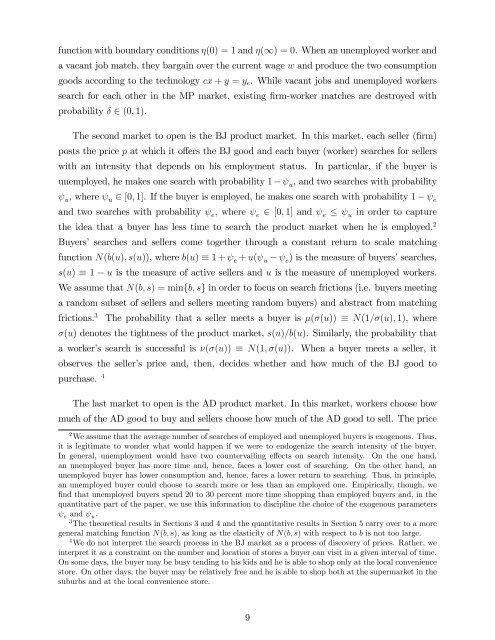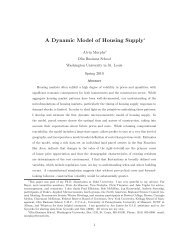Shopping Externalities and Self Fulfilling Unemployment Fluctuations*
Shopping Externalities and Self Fulfilling Unemployment Fluctuations*
Shopping Externalities and Self Fulfilling Unemployment Fluctuations*
Create successful ePaper yourself
Turn your PDF publications into a flip-book with our unique Google optimized e-Paper software.
function with boundary conditions (0) = 1 <strong>and</strong> (1) = 0. When an unemployed worker <strong>and</strong>a vacant job match, they bargain over the current wage w <strong>and</strong> produce the two consumptiongoods according to the technology cx + y = y e . While vacant jobs <strong>and</strong> unemployed workerssearch for each other in the MP market, existing …rm-worker matches are destroyed withprobability 2 (0; 1).The second market to open is the BJ product market. In this market, each seller (…rm)posts the price p at which it o¤ers the BJ good <strong>and</strong> each buyer (worker) searches for sellerswith an intensity that depends on his employment status.In particular, if the buyer isunemployed, he makes one search with probability 1 u , <strong>and</strong> two searches with probabilityu, where u 2 [0; 1]. If the buyer is employed, he makes one search with probability 1 e<strong>and</strong> two searches with probability e , where e 2 [0; 1] <strong>and</strong> e u in order to capturethe idea that a buyer has less time to search the product market when he is employed. 2Buyers’ searches <strong>and</strong> sellers come together through a constant return to scale matchingfunction N(b(u); s(u)), where b(u) 1 + e + u( u e ) is the measure of buyers’searches,s(u) 1u is the measure of active sellers <strong>and</strong> u is the measure of unemployed workers.We assume that N(b; s) = minfb; sg in order to focus on search frictions (i.e. buyers meetinga r<strong>and</strong>om subset of sellers <strong>and</strong> sellers meeting r<strong>and</strong>om buyers) <strong>and</strong> abstract from matchingfrictions. 3The probability that a seller meets a buyer is ((u)) N(1=(u); 1), where(u) denotes the tightness of the product market, s(u)=b(u). Similarly, the probability thata worker’s search is successful is ((u)) N(1; (u)). When a buyer meets a seller, itobserves the seller’s price <strong>and</strong>, then, decides whether <strong>and</strong> how much of the BJ good topurchase. 4The last market to open is the AD product market. In this market, workers choose howmuch of the AD good to buy <strong>and</strong> sellers choose how much of the AD good to sell. The price2 We assume that the average number of searches of employed <strong>and</strong> unemployed buyers is exogenous. Thus,it is legitimate to wonder what would happen if we were to endogenize the search intensity of the buyer.In general, unemployment would have two countervailing e¤ects on search intensity. On the one h<strong>and</strong>,an unemployed buyer has more time <strong>and</strong>, hence, faces a lower cost of searching. On the other h<strong>and</strong>, anunemployed buyer has lower consumption <strong>and</strong>, hence, faces a lower return to searching. Thus, in principle,an unemployed buyer could choose to search more or less than an employed one. Empirically, though, we…nd that unemployed buyers spend 20 to 30 percent more time shopping than employed buyers <strong>and</strong>, in thequantitative part of the paper, we use this information to discipline the choice of the exogenous parameterse <strong>and</strong> u .3 The theoretical results in Sections 3 <strong>and</strong> 4 <strong>and</strong> the quantitative results in Section 5 carry over to a moregeneral matching function N(b; s); as long as the elasticity of N(b; s) with respect to b is not too large.4 We do not interpret the search process in the BJ market as a process of discovery of prices. Rather, weinterpret it as a constraint on the number <strong>and</strong> location of stores a buyer can visit in a given interval of time.On some days, the buyer may be busy tending to his kids <strong>and</strong> he is able to shop only at the local conveniencestore. On other days, the buyer may be relatively free <strong>and</strong> he is able to shop both at the supermarket in thesuburbs <strong>and</strong> at the local convenience store.9
















